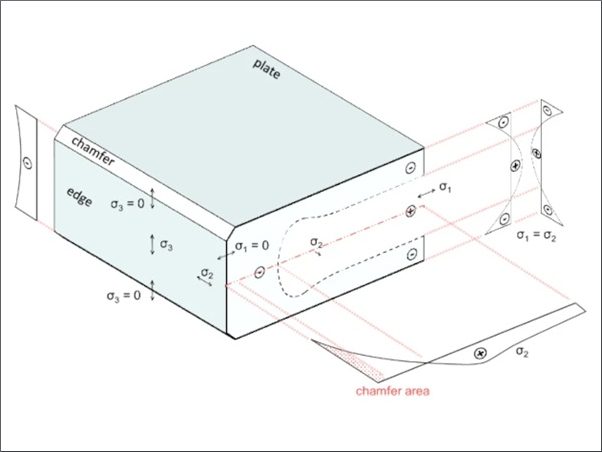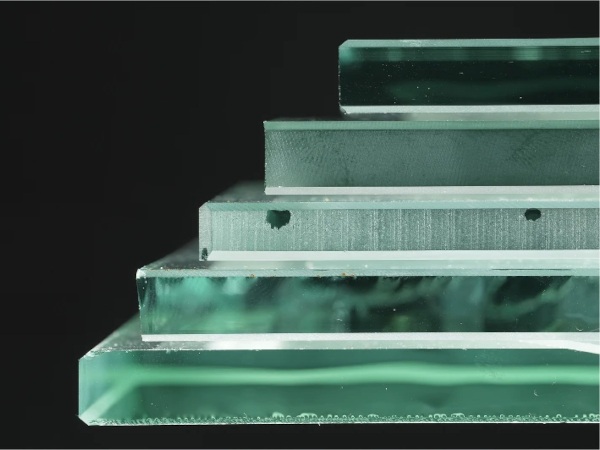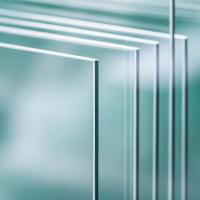Glass can always break whether window film is installed or not (for fully tempered glass see below). However, the risk of breakage from thermal stress is usually very low when the glass (i) is in good, undamaged condition and (ii) complies with the appropriate European and national standards. The relative strengths of different types of glass are1:

How is thermal stress caused?
Thermal stress in a glass pane is caused by a temperature difference in one part of the glass sheet compared to another part. The greater the temperature difference, the greater the thermal stress. Solar energy is the single major cause of temperature difference in glass; the process of thermal stress breakage is shown in Figures 1 to 3.
.jpg)
Table 1 indicates the thermal stress resistance of glass from temperature differences in the glass pane; tempered glass has very much more resistance to temperature differences (thermal stress) than float glass2:

Click to enlarge.
Table 1 Temperature differences that different glass types can resist (for glass in good undamaged condition)
TEMPERED GLASS will never be exposed to excess thermal stress in architectural applications (except in a fire). HEAT STRENGTHENED GLASS is highly unlikely to experience excessive thermal stress1. ANNEALED GLASS is subject to thermal stress breakage. Window film can be installed onto tempered glass without any further assessment of thermal stress compatibility, or onto heat strengthened glass with only a check of any particular conditions that could cause high thermal stress. Of course, installation of the window film onto annealed glass (including FLOAT GLASS) should always be assessed for film-to-glass compatibility.
What does a thermal stress breakage in glass look like?
Figure 4 shows the characteristics of thermal stress breakage in float glass. If a crack has all these characteristics then it is likely to be caused by thermal stress; if the crack does not have all these features then it is definitely not caused by thermal stress.
.jpg)
Figure 4 Characteristics of thermal stress fracture in float glass3
Key:
A = edge of float glass
B = surface of float glass
C = origin of fracture (not near a corner)
D = angles the thermal stress fracture makes with the glass edge and surface = 90º
Window film compatibility with glass – thermal stress factors to consider
The aim of correctly specifying window film is to keep the risk of thermal stress breakage to a low level.
Factors to consider: Glazing and Environmental
There are various factors involved in the compatibility of window films with glass, including film type, glass type, glass colour and/or coatings, glass thickness, glazing type, pane size, external shading, backup materials (such as blinds and curtains), frame type, altitude and solar energy intensity.
Window film will never cause thermal stress breakage with tempered (also known as toughened) glass4, and is highly unlikely to cause thermal stress breakage with heat strengthened glass. Window film can significantly increase the risk of thermal stress breakage of float glass if incorrectly specified.
Factors to consider: Window film
The important properties of the film are its solar energy transmission, reflection and absorption, the most important being solar energy absorption. Solar-optical properties of window film vary according to the film selected and the glazing system construction (glass type, thickness, etc.). Solar energy transmission, reflection or absorption values for one glazing system + window film can give misleading information on compatibility compared with a different glazing system using the same window film.
Window film manufacturers have developed film-to-glass thermal stress compatibility recommendations for the most common glazing systems, generally making the assessment process quick and easy for the trained professional.
How can I keep the risk of thermal stress breakage to a low level?
A professional thermal stress compatibility assessment is essential, which will consider all the relevant factors such as those given above.
As long as the window film installation has been professionally assessed for compatibility with the glass/glazing according to these types of factors, the risk of thermal stress breakage will remain low. The risk can never be zero due to the natural properties of glass. The window film manufacturer, distributor or installer should always be consulted for specific checks on thermal stress and film-glass compatibility and for advice on which films are suitable for your glass and glazing – the quick and easy consultation service is free of charge.
Please see our Contacts list for assessment of film-to-glass thermal stress compatibility.
Source: © EWFA - (European Window Film Association )
1 "Glass in Building" p 252-3, edited by David Button & Brian Pye, published by Pilkington Glass Ltd with Butterworth Architecture.
2 For glass in good, undamaged condition and complying with European and national standards; these values are taken from Pilkington publication "Glass and Thermal Safety". Values for glass manufactured outside the European Union may vary.
3 This is characteristic of glass breakage due to low thermal stress. A break due to high thermal stress has the same characteristics but will have additional small fracture lines either side of the break at 90°. Low thermal stress breakage is often due to glass damage.
4 Tempered glass resists a temperature difference of about 250 °C; polyester window film has very high shrinkage at temperatures above 200 °C and melts at about 265 °C.



























